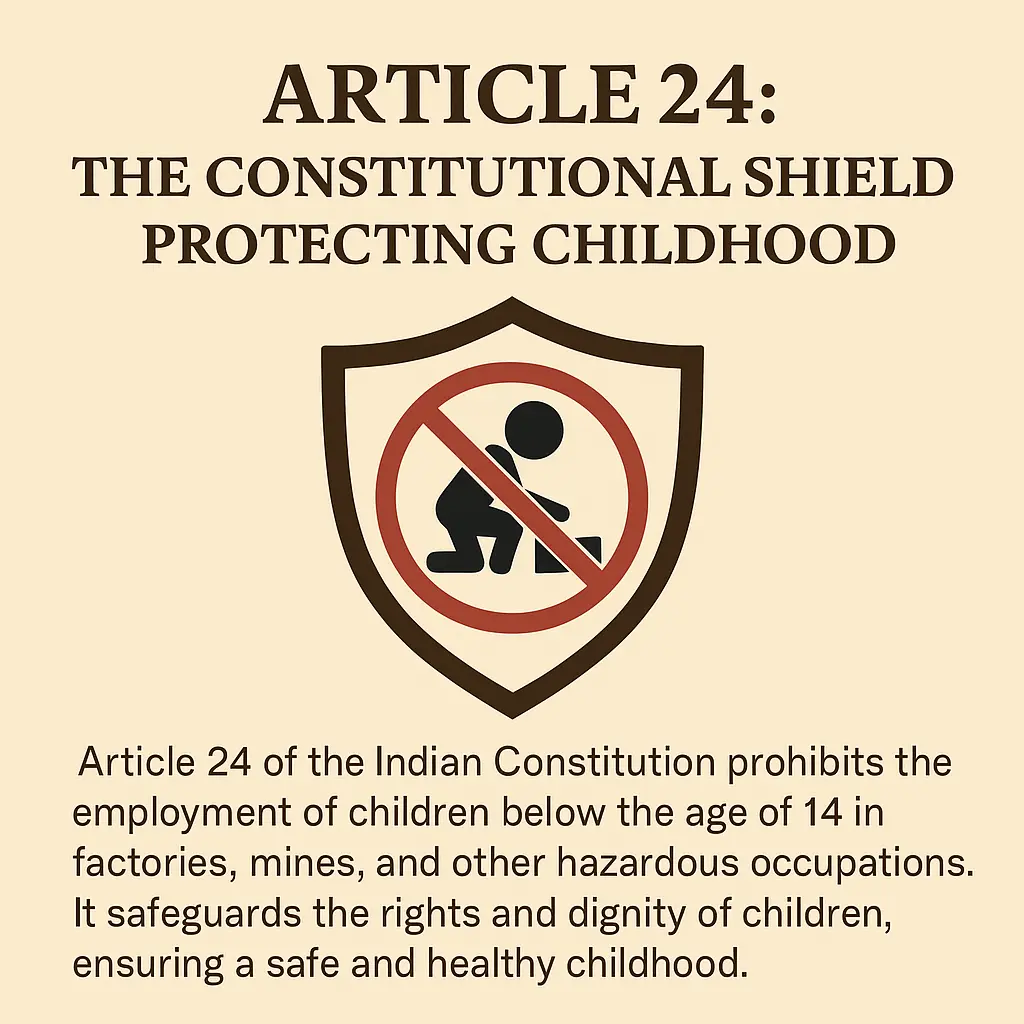Article 24 of the indian constitution
Article 24 of the Indian Constitution, the second pillar of the “Right against Exploitation,” is a specific and absolute prohibition aimed at protecting the most vulnerable section of society: children.1 It represents the Constitution’s firm resolve to ensure that childhood is a period of growth, education, and development, not one of toil and exploitation. By banning child labour in hazardous environments, Article 24 works in tandem with other constitutional provisions to build a legal and moral framework that prioritizes the well-being and future of India’s children.

The Explicit Prohibition: A Clear and Focused Mandate
“Prohibition of employment of children in factories, etc. — No child below the age of fourteen years shall be employed to work in any factory or mine or engaged in any other hazardous employment.”
The key components of this article are:
- An Absolute Ban: Unlike many other fundamental rights, the prohibition in Article 24 is not subject to any “reasonable restrictions.” It is an absolute ban on the employment of children below the age of 14 in the specified areas.4
- Specific Prohibitions: The article explicitly names “factory” and “mine” as prohibited places of work.5These were two of the most notorious sectors for child exploitation at the time the Constitution was framed.
- A Broad Catch-all Provision: The phrase “any other hazardous employment” grants the legislature the power to expand the list of prohibited occupations. What constitutes “hazardous” is determined by Parliament and state legislatures through subsequent laws, allowing the prohibition to adapt to changing industrial landscapes.
It is important to note that Article 24 does not prohibit the employment of children in all forms of work. The constitutional ban is specifically targeted at work that is dangerous and likely to harm a child’s physical or mental development.6 Employment in non-hazardous activities was not constitutionally barred, though it has been progressively regulated by legislation.
The Legislative Framework: From Regulation to Prohibition
To enforce the constitutional mandate of Article 24, Parliament has enacted several key laws over the years, reflecting an evolving approach to the issue of child labour.
- The Child Labour (Prohibition and Regulation) Act, 1986: For three decades, this was the principal law governing child labour in India. It adopted a dual approach: it prohibited the employment of children below 14 in a specific list of hazardous occupations and processes, while regulating the working conditions in non-hazardous jobs.7
- The Child Labour (Prohibition and Regulation) Amendment Act, 2016: This was a landmark amendment that significantly strengthened the legal framework.8 Its key changes include:
- Complete Prohibition for Children: It introduced a complete ban on the employment of children below 14 years in all occupations and processes, not just hazardous ones. This brought the law in line with the Right to Education Act.
- Introduction of “Adolescents”: It defined a new category of “adolescents” (persons between 14 and 18 years of age) and prohibited their employment in specified hazardous occupations and processes.9
- Stricter Punishments: It enhanced the punishment for employers violating the law, making the offence cognizable.10
- Exceptions: The amendment carved out two notable exceptions for children: helping their family or in a family enterprise (outside of school hours and not in a hazardous occupation) and working as an artist in the audio-visual entertainment industry. These exceptions have been a subject of debate among child rights activists.
The Synergy with the Right to Education (Article 21A)
The 2016 amendment created a powerful synergy between Article 24 and Article 21A, which guarantees the fundamental right to free and compulsory education for all children between the ages of 6 and 14. By imposing a near-blanket ban on the employment of children under 14, Article 24 is no longer just a negative right against exploitation; it actively facilitates the positive right to education.11 If a child cannot be employed, the path to sending them to school is cleared of a major obstacle. Together, these two articles form a constitutional pincer movement against child labour, aiming to get children out of workplaces and into classrooms.
The Role of the Judiciary: Expanding Protections
The Indian judiciary has been a proactive force in interpreting and enforcing Article 24.
The most significant judgment is M.C. Mehta v. State of Tamil Nadu (1996), which dealt with the hazardous conditions faced by children in the matchstick and fireworks industries of Sivakasi. The Supreme Court issued a series of comprehensive directions that went beyond mere prohibition. It held that:
- The employer of a child in a hazardous industry must pay a compensation of ₹20,000, which would be deposited into a Child Labour Rehabilitation-cum-Welfare Fund.12
- The State government must either provide a job to an adult member of the child’s family or contribute ₹5,000 to the fund if employment is not possible.
- The child must be enrolled in a school, and the financial assistance to the family was made conditional on the child’s school attendance.
This judgment established a clear link between prohibition, rehabilitation, and education, creating a holistic framework to tackle the root causes of child labour, particularly poverty.
A Constitutional Commitment to a Safe Childhood
Article 24 is a clear and powerful statement of the Constitution’s commitment to protecting children. It recognizes their unique vulnerability and their right to a childhood free from the burdens of dangerous labour.13 While the legislative framework has evolved from partial regulation to a near-complete prohibition for children under 14, the ultimate success of Article 24 depends on robust enforcement and a societal shift that values education over exploitation. In conjunction with the right to education, it stands as a fundamental pillar in the nation’s effort to ensure that every child has the opportunity to develop to their fullest potential in a safe and nurturing environment.





